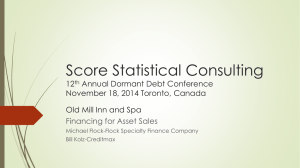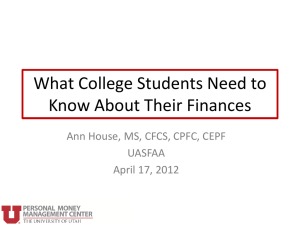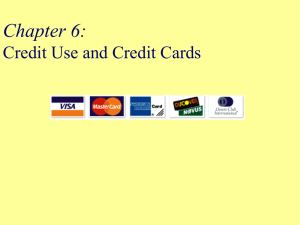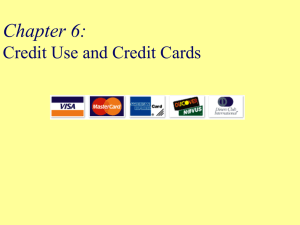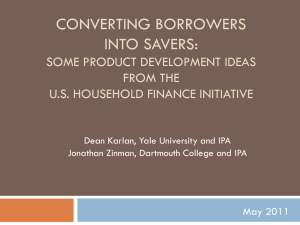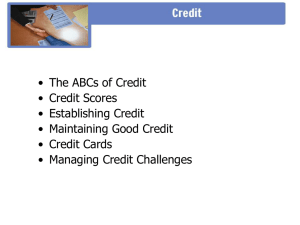Section 108 Underwriting - National Community Development
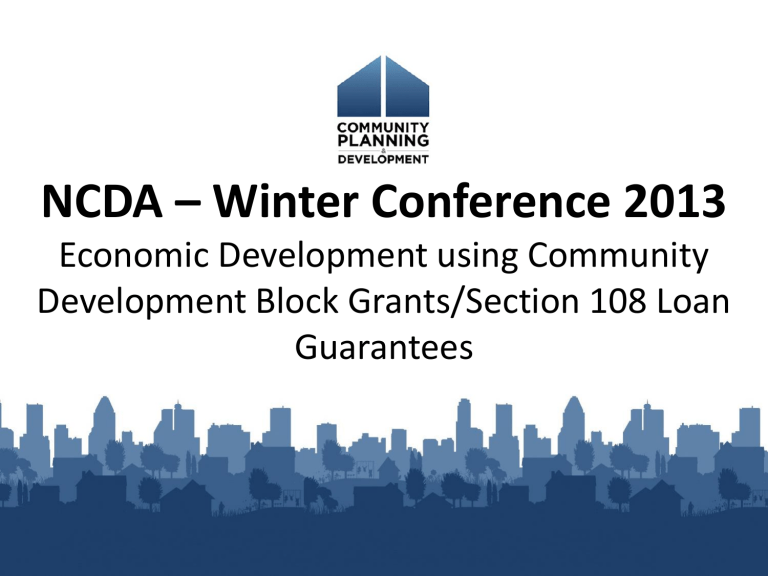
NCDA – Winter Conference 2013
Economic Development using Community
Development Block Grants/Section 108 Loan
Guarantees
Types of Section 108 Projects
• Commercial development
– Offices, retail, mixed-use, hotel
• Operating businesses
– Manufacturing and service sector businesses
• Industrial development
– Industrial park
Slide 2
Types of Section 108 Projects
• Loan Pools
– Business development & expansions
• Multi-family rental housing rehab
– Rehab vacant building into residential use
• Infrastructure/Public facilities
– Community center, roadwork, under grounding utilities
Slide 3
Uses of 108
Slide 4
Why Use Section 108?
• Job creation
• Larger, capital-intensive projects
• Below-market interest rates
• Flexible financing options
• Mitigate impact of CDBG cuts
Slide 5
Section 108 Advantages
• Spread capital costs over time
• Long-term funds at reasonable fixed rates
• Flexibility in repayment
– Provision for interest-only
• Flexibility in structure
– Senior debt instrument
– Subordinated debt instrument
Slide 6
Section 108 Advantages
• Leverage of limited public dollars
($5 of Section 108 for every $1 CDBG funds)
• Non-competitive & rolling application process
• Not a General Obligation (GO) for borrowing community
• Local decision-making
Slide 7
Section 108 Basics
Lending Features
• Long-term debt: up to 20 year term
• Flexibility of loan structure
– Possibility of interest only payments
– Flexible principal repayment schedule
– Negotiable collateral/subordination arrangements
• Historic low interest rates
– Short-term, interim rates - 3 month LIBOR and
– Long-term, permanent rates - “low spread" above the 2, 5, 7, and 10-year U.S. Treasury notes
Slide 9
Section 108 Underwriting:
Program and Financial
Program Underwriting
Eligible Applicants
(24 CFR 570.702 and 570.711)
• Entitlements jurisdictions
• Non-entitlement public entities assisted by states that administer CDBG (Small Cities)
• States (added in 2009) – conduit for Section
108 loans to non-entitlements
Slide 12
Program Underwriting Basics
– Eligible Activities
• Subpart M
– National Objectives
• 24 CFR 570.703
• Subpart C • 24 CFR 570.208
• 70% low-mod benefit – primary objective
– Public Benefit 24 CFR 570.209(b)
• If “special economic development” activity
• If public improvements shared by more than 1 business
Slide 13
Financial Underwriting
Risk & Return
• Risk and return affect both lenders’ (debt) and owners’/investors’ (equity) willingness to fund a deal
• Private Debt: Risk of repayment, operating losses
• Equity: Risk of not earning rate of return
• Risks for Section 108 applicant include
– Program compliance, including public benefits/# of jobs
– Repayment from 3 rd party to local government for repaying Section 108 funds
Slide 15
Section 108
Financial Underwriting
• 24 CFR 570.209(a) and 24 CFR 570 Appendix A provides six key underwriting and evaluation guidelines for economic development projects
• Following guidelines not mandatory, but must conduct basic underwriting in order to receive a Section 108 loan
Slide 16
Six Financial
Underwriting Guidelines
1. Costs are reasonable
2. Financing is committed
3. Section 108 is not substituting for non-federal funding
4. Project is financially feasible
5. Return to owner is reasonable (avoid windfall benefits or undue enrichment)
6. Pro-rata disbursements of funding
Slide 17
Sources & Uses
• Understand features of all financial “Sources”
• Confirm and evaluate “Uses” of funds
• Do “Sources” = “Uses” ?
Slide 18
Sources
• Debt—borrowing from lenders
• Equity—ownership/investor
– Cash or contributed asset
• Section 108 — “gap” subsidy
Slide 19
Uses
• Identify where the money goes
– Breakout project’s hard costs (construction, equipment) and soft costs (e.g., professional/financing fees)
• Evaluate reasonableness of all costs
– Compare to costs standards
• Schedule draws of Sources to timing of Uses
– Predevelopment, closing, construction, cost certification, certificate of occupancy, lease-up
Slide 20
Cash Flow
Real Estate
Income
Business
Sales
- Expenses
(no depreciation or interest)
= Net Operating Income
- Cost of Sales + G&A
= Earnings b/f Taxes, Depr., interest
Minus Debt
= Cash Flow
Minus Debt
= Cash Flow
Minus Income Taxes Minus Income Taxes
Slide 21
Collateral:
Pledge of CDBG
• All Section 108 Guaranteed Loans require pledge of current and future CDBG for repayment of Section
108 loan
– States pledge CDBG for non-entitlement communities’
Section 108 guaranteed loans
– Entitlement communities pledge CDBG for entitlement communities’ Section 108 guaranteed loans
Slide 22
Collateral:
Additional Loan Security
• In addition to CDBG pledge, other security is required. (Evaluate Adequacy of Collateral):
– Real Property: 80% Loan-to-Value
– Machinery & Equipment:
• New: 80% of cost, less other senior debt
• Used: 90% of appraised net liquidation value, less other senior debt
– Inventory: 50% of average of ending balances of last 3 operating years
– Accounts Receivable: 80% of average of ending balances of last 3 operating years
– Revenues (e.g., Tax Increment Financing, parking revenues, revenues from loan portfolios)
Slide 23
Structuring the 108
• Can the deal be done without Section 108?
• Debt has to be sized to fit cash flow
- DSC (Debt Service Coverage)
• Debt has to be sized to fit collateral
– LTV (Loan to Value)
Slide 24
Structuring the 108
•
•
Level I: Community borrows funds to carry out community/economic development activity
–
–
Repaid with CDBG funds over term; and/or
Repaid with other pledged revenue sources (e.g. TIF)
–
Flexibility and variation depending on project type, source of repayment, and nature of parties
Level II: Community borrows funds to re-lend to
Third Party Borrower (business or developer)
–
–
Repaid by Third Party Borrower with revenues from project;
Repaid by Third Party Borrower with other pledged revenue sources and guarantees
Slide 25
Repayment Sources
• Level I – Loan
– Repayment - generally, CDBG used as source of repayment
– Collateral
• pledge of existing and future CDBG
• Pledge of additional loan security
Slide 26
Repayments - Third-Party Loan
• Level II - Loan
• Repayment
– 3 rd party borrower loan payment (p & i) to local government borrower. Debt service payment cannot be less than Section108 debt service
• Collateral
- CDBG pledged by State or Unit of local gov’t
- Additional loan Security – State or Unit of Local gov’t pledges interest in 3 rd party loan, including security for loan
Slide 27
Section 108
Examples
Example: Business Deal
• Local food products business founded in 2006
• Existing 18,000 sq. ft. facility seeking to expand.
• Experienced business owner
• Total project cost is $2.6 mil,
• Section 108 request is for $469,000
• Sources of funds : bank loan, SBA loan and owner equity(cash).
Slide 29
Example: Business deal continued
• Uses of funds:
– purchase a 25,000 sq. ft. building
– purchase additional equipment
– Working Capital
• Benefit: Job creation ( 25 FTE) in LM area
Underwriting process is two-fold:
• Program requirements
• Financial
Slide 30
Example Business Deal
Program Underwriting
• Eligible Activity: Special Economic Development 24
CFR 570.203/570.703(i)(1)
• Nat. Objective: Benefit to LM persons through job creation 24 CFR 570.208(a)4(i) and (v)
• Public Benefit : Applicable per 24 CFR 570.209(b) # jobs created & retained < $50k in CDBG $$(incl. 108) per job [ $469,000/25 = $18,760 per job]
Slide 31
Cash Flow
Real Estate
Income
Business
Sales
- Expenses
(no depreciation or interest)
= Net Operating Income
- Cost of Sales + G&A
= Earnings b/f Taxes, Depr., interest
Minus Debt
= Cash Flow
Minus Debt
= Cash Flow
Minus Income Taxes Minus Income Taxes
Slide 32
Example Business Deal
Financial Underwriting
• Profit and Loss(P&L) statement Analysis:
– Trend is gradual growth (increase in sales)
– Trend is stable cost of goods(COGS) compared to sales
• Cash Flow Analysis:
– Sales – (Cost of Sales + G&A)=Earnings b/f Taxes, Depr., int.
– cash flow available for debt service / total debt service
(incl. 108)
– Desire at least 1.2 for 108 deals
Slide 33
Financial Underwriting contd.
• Balance Sheet Analysis :
– positive & increasing working capital[current assets(CA)current liabilities(CL)]
– Stable Current ratio [CA\CL]
– Good cash mgmt( receivable and payable ratios averaged less than
40 days)
• All other funds are committed
– Commitment letter from bank and net worth statement of owner were submitted with application.
Slide 34
Business Deal Underwriting
Conclusion
• Program requirements are met
• Finance:
Costs are reasonable compared to similar businesses
Other Financing is firmly committed incl private financing
Project seems financial feasible
Owner is not unduly enriched
Pro-rata timing of disbursement
• Project is recommended for funding
Slide 35
Example: Mixed-Use Real Estate
Deal
Slide 36
Memphis, TN—Court Square Center:
Programmatic Underwriting
– Eligibility of Activities
• Development of commercial/office/retail space, under
24 CFR 570.703(i)(1) and 570.203(b)
• Rehabilitation of housing, under 24 CFR 570.703(h) and
570.202(b)(1)
– National Objective
• Elimination of slums or blight, pursuant to 24 CFR
570.208(b)(1)
– Applicable Public Benefit Standards [570.209(b)]
• $3,500,000/140 FTEs= $25,000 per FTE
Slide 37
Cash Flow
Real Estate
Income
Business
Sales
- Expenses
(no depreciation or interest)
= Net Operating Income
- Cost of Sales + G&A
= Earnings b/f Taxes, Depr., interest
Minus Debt
= Cash Flow
Minus Debt
= Cash Flow
Minus Income Taxes Minus Income Taxes
Slide 38
Memphis, TN—Court Square
Center: Financial Underwriting
Cash Flow
Operating Income
Operating expenses -
$2,107,000
$343,000
Other Project Expenses $559,000
Net Operating Income (NOI) = $1,205,000
Annual Debt Payment= $916,800
NOI ÷ ADP = Debt Coverage Ratio (DCR) of 1.31
Slide 39
Memphis, TN—Court Square
Center: Financial Underwriting
Collateral
– Partnership Interests
– Lien on Real Property
• Loan to Value = less than 80%
Slide 40
Section 108
Application & Approval Steps
Application Pre-submission
Requirements (24 CFR 570.704(a))
• Consult with HUD Field Office
• Draft application and publish for citizen review and comment
• Prepare final application, with citizen comments considered
Slide 42
Final Application Components
1. Project Description
2. Eligible Activity(ies)
3. National Objective
4. Public Benefit Standard
5. Sources and Uses
6. Project Structure and Participants
Slide 43
Timing
• HUD approval of application for Section 108 loan guarantee commitment is approximately
90 days. It depends on a number of factors:
– Quality of the application and whether additional documentation is required
– Complexity of project
– Time of year (near holidays, budget hearings, and local processes)
Slide 44
Section108 Loan Guarantee
• Promissory Notes
- Variable/Fixed interest rate notes issued by states or units of local gov’t.s
• Loan Guarantee
- HUD issues loan guarantee for each note pledging full faith and credit of U. S. for repayment of each note
Slide 45
Contact Information
• Paul Webster – Director, Financial
Management Division (FMD) – 202-708-1871
• Hugh Allen – Deputy Director, FMD, 202-402-
4654
Slide 46
